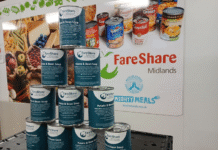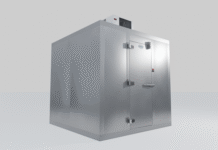
Light, unbreakable and sustainable – with its aluminum bottles, Hinterkopf talked about and demonstrated alternative packaging for wine at the recent Metpack exhibition in Essen. The 250 ml packaging is easy to transport and as an on-the-go packaging solution, allows special moments of pleasure anytime and anywhere. Modern digital printing technology enables individual packaging concepts that are also economically attractive for smaller wineries.
In many respects, wine production is a trade shaped by tradition. One of them: bottling in glass bottles with mostly 0.75-liter content. It is precisely these that have been the subject of discussion in the industry for some time. After all, the large, heavy bottles are often transported long-distance (hundreds of miles or kilometers) from the winery or bottler to the consumer. This practice is not sustainable. But even with local or regional sales, glass bottles remain a bulky commodity for a mobile society. Because in a backpack or a body pack, the urban heirs to briefcases and shopping bags, glass containers are not only uncomfortable, but they’re also always at risk of breaking.

Wine for modern society – more than just a glass replacement
With its attractively decorated, light, and unbreakable aluminum bottles for wine, Hinterkopf, based in Eislingen in Germany, insists its innovation offers much more than a fashionable alternative to the traditional large glass bottle. It also offers smaller wineries and winegrowers the option of presenting their product in a high-quality way with minimal packaging runs. Digitally printed beverage cans already offer this possibility to craft breweries.

As Alexander Hinterkopf, managing director of the family-run company specializing in the production and printing of tubes, cans, and sleeves made of aluminum and plastic, explained, “With our digital printing technology, winegrowers can easily implement an individual marketing concept on the bottles – and this extremely economically. Because with digital printing, the costs for decoration are linear. The price for printing per bottle is, therefore, always the same, regardless of whether it is a small series or a batch with one million containers. Even the smallest batch sizes for limited editions can, therefore, be produced economically. Even a one-off or a sample container costs no more than a large-quantity bottle. This is particularly attractive for smaller wineries that only produce relatively small quantities from one location.”
Effortless individualized packaging
Another advantage of digital printing is the extremely brilliant, printed image from the first to the last bottle in a batch. The latest generation of Hinterkopf digital printing machines allow resolutions of up to 1,800 dpi, maximum edge sharpness, legible printing of very small font sizes, and the uniform representation of color gradients even on large areas.
The decoration can cover the entire bottle and is not limited to just a small area of a paper label. This gives winemakers completely new opportunities to stand out from the competition on the shelf with striking designs. “With wine, the producer almost always stands for the product with his name. He sells individual, naturally produced, and high-quality products. Of course, such aspects can be communicated well with a correspondingly attractive graphic design of the bottle,” explains Hinterkopf.
Beverage on the go
Aluminum bottles not only offer the advantage of being unbreakable. Due to the higher thermal conductivity compared to glass and better cold storage, the contents can be cooled down to the desired drinking temperature faster, that is with more energy efficiency – and then maintain the cool temperature longer.
The screw cap also prevents the wine from corking if it is stored for a long time. In addition, the reliable sealability keeps the contents fresh from the first to the last sip. These properties also make the packaging system interesting for people who travel a lot and prefer to enjoy wine as a drink instead of a cola or beer. For this reason, Hinterkopf uses a bottle size of 250 milliliters that can easily be stowed and carried for on-the-go enjoyment.
More sustainable than recycled glass
The consistently high recycling rate for aluminum is another advantage of the packaging material. In the future, aluminum wine bottles in Germany will also participate in the DPG deposit system, thereby significantly improving return rates. Hinterkopf expects that between 80 and 95% of the bottles sold will be recycled – a process that is much more efficient and sustainable than with glass bottles.
The fact is that the reprocessing of aluminum requires less energy than that of glass. In addition, a new identical bottle can always be created from laterally recycled aluminum bottles. In the case of glass, color impurities ensure after just a few cycles that the green glass that is characteristic of wine bottles can no longer be produced. “The aluminum wine bottle combines the best of all worlds in terms of quality, freshness, and sustainability. It strikes a chord with a young generation of consumers,” adds Hinterkopf.
The first project of the new packaging concept will start next September this year in cooperation with Spanish winegrowers. Hinterkopf plans to print around 25 million aluminum bottles on a digital printing machine in the course of 2024. Three more plants are to follow and increase the production volume to a total of 100 million bottles by the end of 2025.
IndiFoodBev — authentic, impactful and influential
An English-language food and beverage processing and packaging industry B2B platform in print and web, IndiFoodBev is in its third year of publication. It is said that the Indian food and beverage industries represent approximately US$ 900 billion in revenues which implies more than 20% of the country’s GDP. Eliminating the wastage on the farmside can help to deliver more protein to a higher number of the population apart from generating sizable exports. The savings in soil, seeds, water, fertilizer, energy and ultimately food and nutrition could be the most immense contribution that country is poised to make to the moderation of climate change.
To improve your marketing and grow sales to the food and beverage processing and packaging industry, talk to us. Our research and consulting company IppStar [www.ippstar.org] can assess your potential and addressable markets in light of the competition. We can discuss marketing, communication, and sales strategies for market entry and growth.
Suppliers and service providers with a strategy and budget for targeted marketing can discuss using our hybrid print, web, video, and social media channels to create brand recognition linked to market relevance. Our technical writers are ready to meet you and your customers for content.
The second largest producer of fruit and vegetables in the world is continuously expanding processing capacities and delivery systems with appropriate innovative technologies. We cover product and consumer trends, nutrition, processing, research, equipment and packaging from farm to thali. Get our 2025 media kit and recalibrate your role in this dynamic market. Enhance your visibility and relevance to existing markets and turn potential customers into conversations. Ask for a sample copy of our bi-monthly in print or our weekly IndiFoodBev eZine each Wednesday.
For editorial info@ippgroup.in — for advertisement ads1@ippgroup.in and for subscriptions subscription@ippgroup.in
Naresh Khanna – 10 February 2025
Subscribe Now










